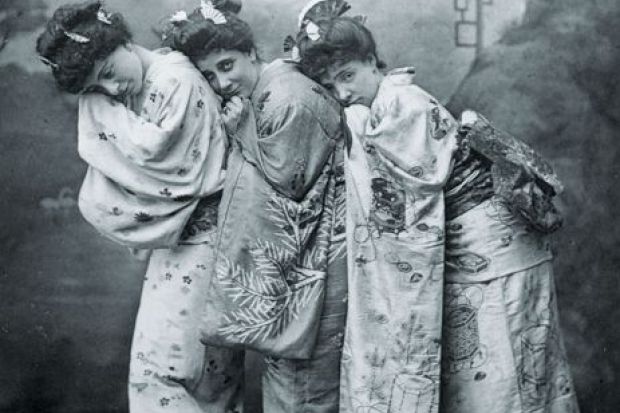To read Quaint, Exquisite is to be reminded of how familiarly embedded within both contemporary and Victorian culture Japan is. The “haiku, the tea ceremony, and the samurai sword” mentioned by Grace E. Lavery, Gilbert and Sullivan’s The Mikado, Puccini’s Madama Butterfly and Nigel Slater’s enthusiastic celebrations of Japanese food subsist alongside trade concerns and economic negotiations.
Lavery’s examination of “Victorian aesthetics and the idea of Japan” roams far more widely than its subtitle suggests in its consideration of “a complex idea about Japan that developed in the English-speaking world in the second half of the nineteenth century”. This is simply a jumping-off point for a book that unpicks the imaginary Japan, and the often conflicting compulsions behind and within that imaginary construct, as well as tracing the descendants of that idea in a wide range of cultural forms. Lavery contends that the sheer complexity of the idea of Japan has generated an uneasy awareness of “the felt inadequacy” of ways of thinking about it. Quaint, Exquisite is an attempt both to analyse and to live up to its subject-matter.
The title enacts the compulsions of the book. Both adjectives were used, albeit rather imprecisely, by the Victorians to describe aspects of Japanese culture. Lavery recognises and revises their usage: “exquisite” is “the point at which converge [an] insuperable beauty and an irresistible violence” associated with Japan; whereas quaintness signals “an oblique, slippery relation to history, a distinctive mode of passing into the past”. To this combination, she adds a “queer historiography” which, she argues, nonetheless leaves the “quaint” ultimately irretrievable by the “histories of repression and emergence, sociability and privation, love and violence that detain queer theory”. This carefully argued set of premises doesn’t, however, preclude insights grounded in specific moments such as that, for “some [homosexual] attendees of the Savoy in 1885”, the realism of The Mikado, “in which flirtation was punishable by death would have been all-too-disturbingly apparent”. But rather than resting with that insight, readers are encouraged to recognise the formative effect of reactions to the comic opera which, historically located though they might originally be, become part of a mutating relationship with the concept of Japan.
Quaint, Exquisite is a beautifully written book, as we can see in Lavery’s reading of the painter James Abbott McNeill Whistler’s telegram to Mortimer Menpes, a one-time acolyte who he believed had betrayed him in an interview. Whistler wrote: “You will blow your brains out, of course”. Lavery comments: “Like Whistler’s ever-changing signature, a mutant butterfly with a sting in its tail, the note is both violently punctual and too-too light, the trace of an intimacy maintained even in its closure, a wounding kind of softness.” Her own lightness of touch, and this sentence that, like Whistler’s, lingers softly as it lands its violence, is intensely pleasurable, as is much of the book. But it is not to be lightly digested: it is peremptory in its demands on the reader; rich and dense; and challengingly generous in its reach. Lavery’s is an invigorating, compellingly collaborative critical voice which demands, and amply repays, the reader’s time and thought.
Gail Marshall is professor of Victorian literature and culture, and head of the School of Literature and Languages, at the University of Reading.
Quaint, Exquisite: Victorian Aesthetics and the Idea of Japan
By Grace E. Lavery
Princeton University Press, 240pp, £35.00
ISBN 9780691183626
Published 28 May 2019




